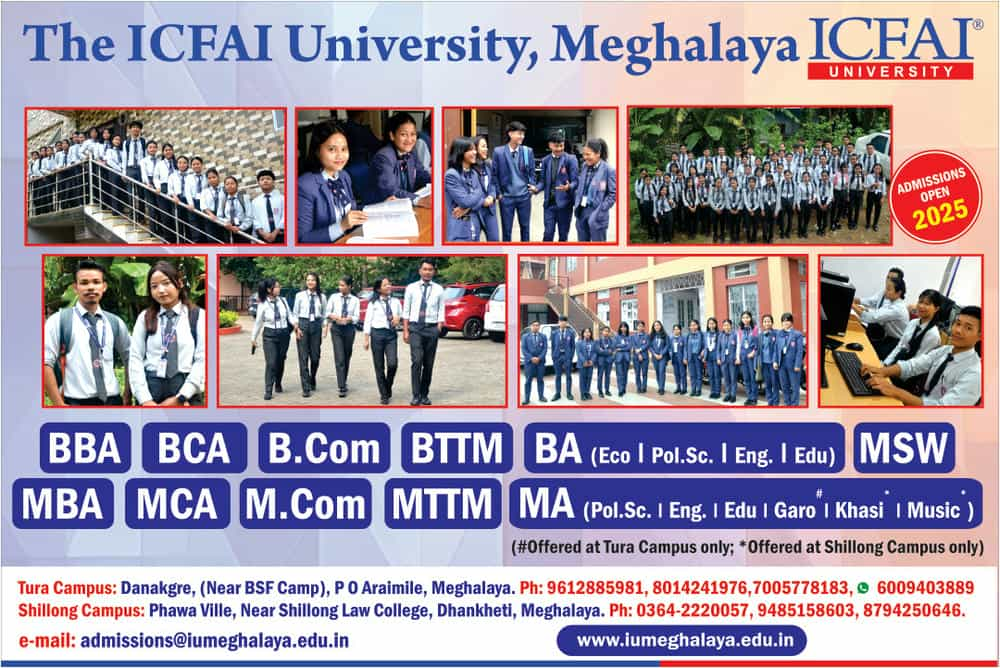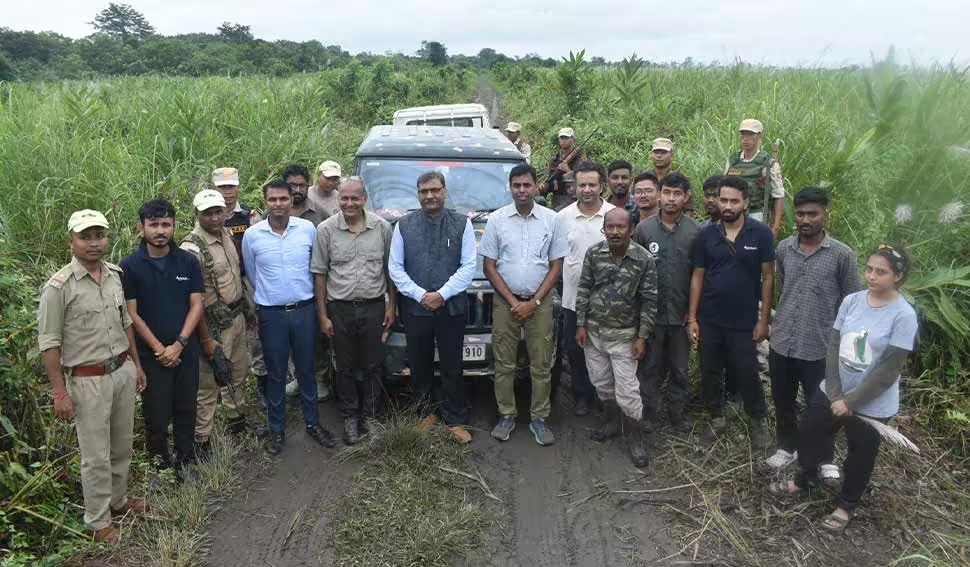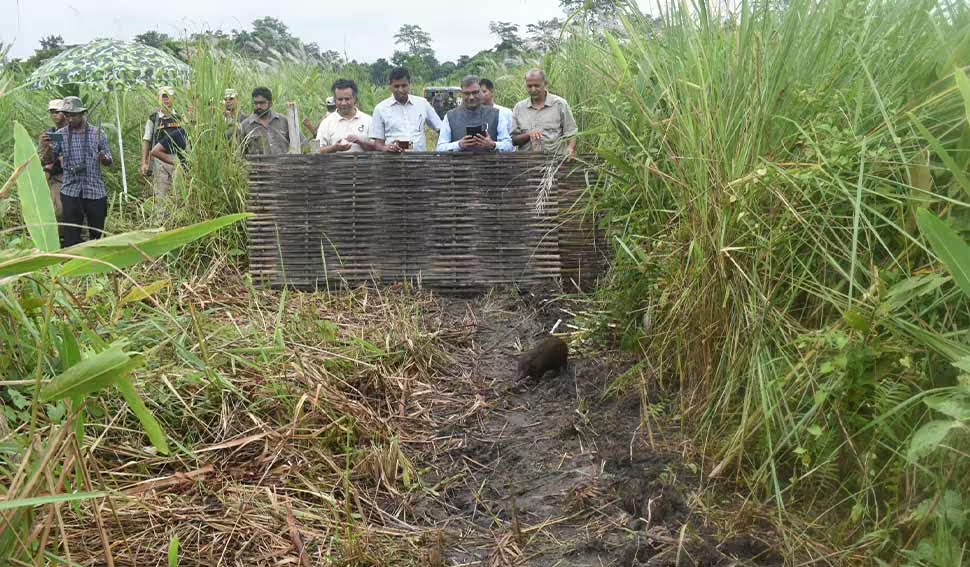Nine captive bred pygmy hogs released in Assam’s Manas National Park

Nine captive-bred pygmy hogs were released in the sprawling Manas National Park of Assam by the Pygmy Hog Conservation Programme (PHCP) on Tuesday.
The pygmy hog (Porcula salvania) is the world’s smallest and rarest wild pig, most threatened by extinction.
The nine pygmy hogs were released in the presence of the Principal Chief Conservator of Forest (PCCF) and Head of the Forest Force (HoFF) RP Singh who said, “The effort for reintroduction and restoring of the endangered Pygmy Hog in Manas National Park under Pygmy Hog Conservation Programme is commendable. I wish the population of the pygmy hog stabilize in this landscape making Manas more vibrant in its species richness.”
This is the fifth release of pygmy hogs into Manas National Park since 2020, which takes the total number of the endangered species released at Kanchnabari Grassland up to 27. A camera trap study in the 2023-release-site has shown that hogs are exploring and now breeding in the area. A pregnant female hog was captured on camera in the wild for the first time in the programme’s history.
The PHCP, which is made up of founding partners Assam Forest Department, Durrell Wildlife Conservation Trust, the IUCN/SSC Wild Pig Specialist Group, Ministry of Environment and Forests, Government of India, and Ecosystems-India, with Aaranyak as delivery partner, has been working to bring this precious species back from the brink after it was previously thought to be extinct in the 1970s.
The PHCP has so far successfully bred and reintroduced 179 hogs in Assam, India, which, and happy to report, for the first time since the reintroduction programme began, may now be outnumbered by their current global wild population.
The Pygmy Hog Conservation Programme (PHCP) started its work in 1996 when two males and two females were captured from the Bansbari Range of Manas National Park. The reintroduction of captive-bred hogs to the wild began in 2008. Prior to releases in Manas National Park, the PHCP selected other appropriate grasslands in Assam for reintroductions of the pygmy hog.
One site, Orang National Park, is located approximately 120km southeast of Manas, on the north riverside of the Brahmaputra River. The park is approximately 200 square km and supports grassland, woodland and ‘mosaic’ habitat types, as well as charismatic species such as the tiger, elephant and rhino.
The pygmy hog was thought to be extinct until it was rediscovered in the 1970s. It remains under significant threat from the loss of its grassland habitat due to invasive alien plant species, disease, and human disturbance.
Fifty-nine pygmy hogs were released in Orang, and the current population is estimated to be 130 hogs. This is made even more exciting as the lifespan of a pygmy hog in the wild is around 8 years, so this population is likely to be made up entirely of wild-born hogs.
Pygmy hogs are extremely shy and secretive in the wild, remain hidden in tall dense grass and rarely emerge in the open, which has made monitoring them at the reintroduction site in Orang National Park a challenge.
The PHCP team of conservationists have worked through this by employing camera traps and undertaking sign surveys, where the team look for pygmy hog pellets, nests, foraging marks, and footprints.
The pygmy hogs have been seen up to 2km away from the nearest release site, showing a healthy dispersal and exploration of the site by reintroduced and wild-born individuals.
Manas National Park contains some of the largest remaining grassland blocks in the sub-Himalayan grassland ecosystems. Field Director, Manas Tiger Reserve Dr C. Ramesh said, “To ensure long-term water security for farming communities living on the periphery of Manas, the restoration of grasslands in this landscape is crucial. These grasslands not only support iconic and charismatic species, but also provide a habitat for smaller animals like the Pygmy Hog. As an endangered species listed on the IUCN Red List, the reintroduction of Pygmy Hogs requires and relies on effective grassland management practices, thereby ensuring these ecosystems; overall health and sustainability.”

The PHCP Field Scientist Dr Dhritiman Das stated, “Maintaining the functionality of grasslands and establishing a stable Pygmy hog population requires integrating habitat management with population monitoring. Ongoing Pygmy hog and habitat monitoring evaluates population trends, ecological dynamics, and reintroduction effectiveness.”
Dr Bibhab Kumar Talukdar, CEO of Aaranyak, a vital partner of the programme, added, “Aaranyak is happy to continue to be a delivery partner of the Pygmy Hog Conservation Programme—an important species recovery programme. I am happy to learn that all the stakeholders of PHCP emphasise grassland habitat restoration for grassland-dependent species. I am sure it will not only help the Pygmy hog but also other grassland-dependent species.”
As part of its rewilding strategy, the PHCP will continue to maintain a small population 80 captive hogs at its two centres in Assam and breed more hogs for release. The strategy for monitoring hogs after their release continues to develop.
For this particular release, the PHCP will employ camera trap and sign surveys and carry out a fourth year of radio-telemetry tracking on six of the pygmy hogs. This will provide critical data about their behaviour after release and the habitat use of reintroduced hogs.


Leave a Reply